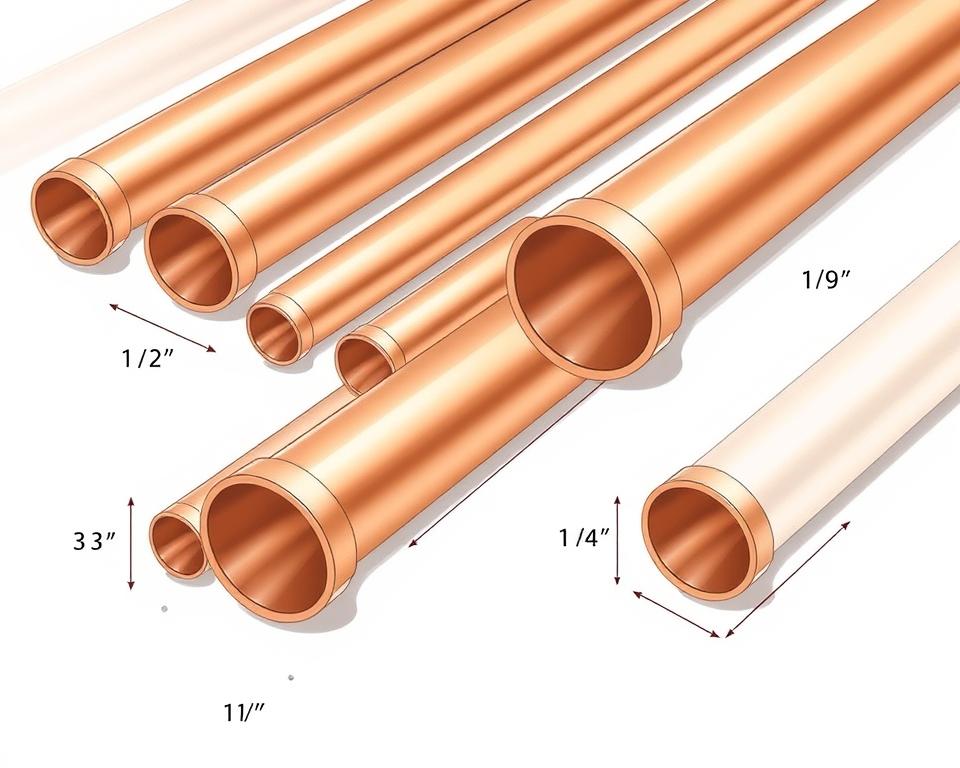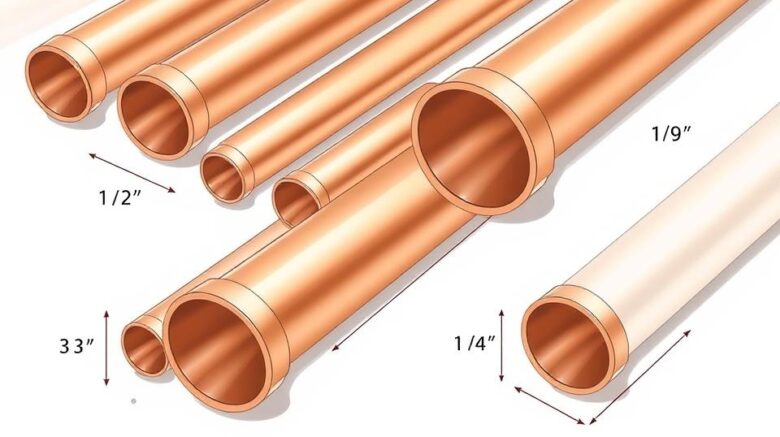Your Guide to Copper Water Line Sizing at Home
Did you know that nearly 30% of home plumbing issues stem from incorrectly sized piping? Using the proper dimensions helps maintain ideal water pressure and system efficiency. This overview assists homeowners in mastering sizing fundamentals for home plumbing.
Determining the right size relies on considerations like required flow and wall measurement. Standard 5/8 copper fittings sizes run between 1/4″ and 8″ across, noted by NPS versus actual exterior measurements. Installation Parts Supply offers expert guidance to match your home’s needs with compliant solutions.
Copper continues leading the pack because of its strength and ability to resist corrosion. Whether you’re upgrading existing systems or planning new installations, understanding these fundamentals saves time and prevents costly mistakes.
Major Findings

- Accurate sizing stops 30% of usual plumbing issues
- Common sizes run between 1/4″ and 8″
- Nominal Pipe Size isn’t the same as true OD
- Right sizing preserves water pressure and performance
- Copper provides robustness and corrosion defense
- Professional guidance ensures code compliance
Reasons to Select Copper for Your Plumbing
Durable plumbing depends on material choice—copper leads the way because: With over 50 years of service life and NSF drinking-water approval, it’s a favorite among homeowners. Unlike alternatives, it combines strength with sustainability.
Longevity and Corrosion Defense
Copper naturally resists rust and chemical damage, outperforming PVC or PEX. Smooth bore reduces friction, keeping water pressure steady. Field cases demonstrate leak-free decades-long service.
Find certified, high-grade selections at Installation Parts Supply for your requirements. Although upfront costs rise, less frequent repairs yield savings over time.
Bendability and Freeze Safety
In chilly regions, copper expands just enough when freezing to avoid splits. This flexibility reduces the risk of costly winter damage. Use alongside suitable insulation for peak frost protection.
Sustainable and Germ-Fighting Properties
Being wholly recyclable, it cuts environmental burden. Its antimicrobial properties inhibit bacteria growth, enhancing water safety. For eco-conscious homeowners, it’s a clear win over plastic alternatives.
Understanding Copper Pipe Water Line Sizes and Types
Homeowners often find pipe measurements confusing—here’s how to simplify them. The industry uses Nominal Pipe Size (NPS), which doesn’t match the actual outer dimensions. As an instance, 1/2″ NPS measures 0.625″ across externally.
Labeled vs. True Pipe Sizes
NPS figures serve as tags, not precise sizes. Always check the outer diameter (OD) before purchasing. Refer to this chart:
- 1/4″ NPS = 0.375″ OD
- 1/2″ NPS corresponds to 0.625″ OD
- 3/4″ NPS = 0.875″ OD
Key Differences Between L, M, and K Types
Residential plumbing relies on three major copper types. Their wall thickness determines strength and use cases:
- Type L: Light gauge (0.040″ @ 1/2″), perfect for standard homes.
- Type M: Medium gauge (0.050″ @ 1/2″), for cost and strength balance.
- Type K: Heavy-wall (0.060″ for 1/2″), for high-pressure systems.
For versatility, Installation Parts Supply favors Type M in most setups. Over 2″ spans usually need Type K for irrigation or business applications.
Type L Copper Pipes: Thin-Wall Versatility
For homeowners tackling DIY projects, L-type offers unmatched flexibility. Thin gauge lightens load and price yet stays robust. Comes both in straight bars and flexible coils for HVAC to DWV work.
Where L-Type Excels and Falls Short
L-type excels in low-pressure scenarios. With 0.040″ walls, it’s great for:
- HVAC refrigerant lines
- Drain-waste-vent (DWV) systems
- Residential water supply (below 80 PSI)
High-pressure? Skip L-type and choose K-type instead. Coils (max 50ft) ease around corners but must be bent cautiously to avoid kinks.
Sizing Options and Installation Tips
Choose from 1/4″ to 8″ diameters, with these popular options:
| Form | Max Length | Best For |
|---|---|---|
| Rigid | 20ft | Straight runs |
| Coiled | 50ft | Tight spaces |
Installation Parts Supply recommends rigid forms for beginners—they’re easier to cut and solder. When tackling big installations, coils mean fewer joints, saving time and leak hazards.
Type M Copper Pipes: The Residential Standard
Balancing cost and performance, M-type emerges as the top pick for modern homes. Medium gauge copes with routine loads yet stays budget-friendly. NSF-certified for potable water and gas lines, it’s a safe choice for kitchens, bathrooms, and heating systems.
M-Type Best Applications
Great for both hot and cold feeds, it sustains consistent water pressure. Use 12ft rigid for long stretches, 100ft coils for narrow pathways. Typical uses cover:
- Drinking water distribution
- Medical gas lines (oxygen, nitrous oxide)
- HVAC refrigerant lines
M-Type Gauge & PSI Ratings
It balances the characteristics of L and K. With 0.050″ walls, it tolerates up to 150 PSI without failure. See the specs contrast:
| Type | Wall Thickness (1/2″) | Max Pressure | Best For |
|---|---|---|---|
| L | 0.040″ | 80 PSI | Low-pressure DWV |
| M | 0.050″ | 150 PSI | Residential supply |
| K | 0.060″ | 200 PSI | Irrigation |
Installation Parts Supply stocks M-type in all standard sizes. Combine with proper flare connectors for gas lines to secure seals. Leave small expansion joints in hot lines for temperature shifts.
Type K Copper for Tough Applications
Under the toughest conditions, K-type provides exceptional endurance. Thick gauge and strong PSI rating enable industrial and subterranean applications. It outperforms slimmer options by standing up to crushing and corrosion.
Heavy-Duty Use Cases
K-type excels where others fail. At 0.060″ gauge, it manages 200 PSI, ideal for:
- Underground irrigation systems
- Commercial HVAC refrigerant lines
- Fire sprinkler networks
When burying, Installation Parts Supply suggests at least 18″ cover. Pair with compression fittings torqued to 25 ft-lbs to prevent leaks.
Rigid vs. Coil: Installation Advice
Select between stick or coil based on needs. Rigid 12ft for long stretches; coils 50ft for complex paths. See their differences:
| Form | Best For | Limitations |
|---|---|---|
| Rigid | High-pressure mains | Requires more fittings |
| Coiled | Trenchless installations | Risk of kinks if bent sharply |
In irrigation layouts, allow 10% for thermal growth. Avoid bending rigid forms without a tube bender—kinks reduce flow efficiency.
Installing and Caring for Copper Pipes
Correct methods deliver years of drip-free operation. Whether you’re a DIY enthusiast or hiring a pro, understanding the basics saves time and avoids headaches. Use these approaches for solid, durable joints.
Connection Options Compared
Select the joining style that fits your task. Permanent joints use heat or compression, while temporary options allow adjustments. Compare the pros and cons:
| Method | Pros | Cons | Best For |
|---|---|---|---|
| Soldering | Strong, permanent | Requires skill | Water supply lines |
| Compression | No heat needed | Bulky fittings | Tight spaces |
| Push-Fit | Quick installation | Higher cost | Emergency repairs |
Soldering Procedure
To solder properly, proceed as follows:
- Use emery cloth to clean both surfaces.
- Spread flux uniformly over the fittings.
- Heat evenly with a torch until the flux sizzles.
- Apply solder to the seam; it will wick in automatically.
Protective gloves and fresh air are a must. Lead-free solder for potable lines is available at Installation Parts Supply.
Avoiding Drips and Freeze Breaks
Use foam insulation on pipes in cold spots. Fit foam sleeves where lines pass exterior walls. Repair advice includes:
- Check joints annually for green corrosion (a sign of leaks).
- Support horizontal runs every 32 inches to prevent sagging.
- Install freeze-proof faucets in cold climates.
Annual inspections catch minor issues before they escalate. Keep a basic toolkit handy for quick fixes—adjustable wrenches, pipe cutters, and Teflon tape cover most scenarios.
Final Thoughts on Copper Pipe Selection
A thoughtfully designed plumbing network endures for years—here are the main points. Choose proper size and type for lasting durability. Keep in mind:
- Type M suits most homes, while K handles heavy-duty jobs
- Right sizing ensures steady pressure and leak prevention
- Freeze protection is critical in cold climates
Installation Parts Supply offers expert guidance to simplify choices. Certified solutions with quality warranties keep your plumbing systems running perfectly.
Looking for assistance? Get free sizing charts or book a consultation now. First-time buyers get exclusive discounts—start your project right!
